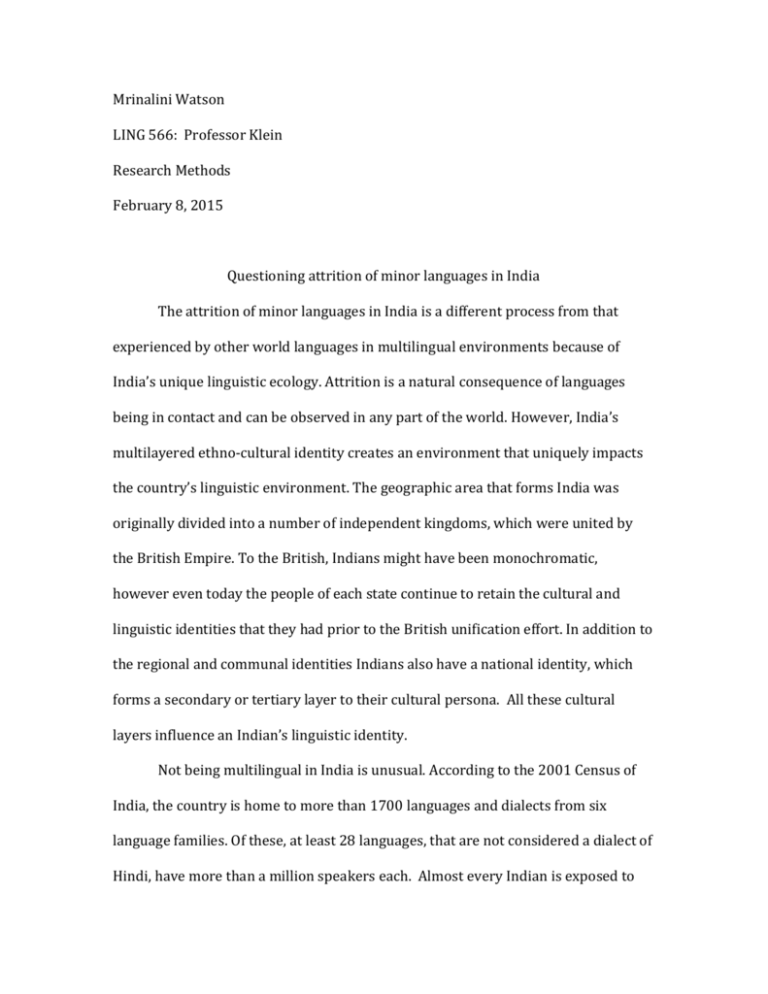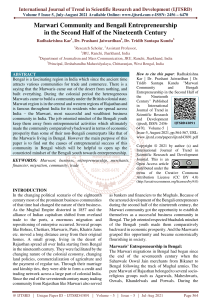Potential research questions
advertisement

Mrinalini Watson LING 566: Professor Klein Research Methods February 8, 2015 Questioning attrition of minor languages in India The attrition of minor languages in India is a different process from that experienced by other world languages in multilingual environments because of India’s unique linguistic ecology. Attrition is a natural consequence of languages being in contact and can be observed in any part of the world. However, India’s multilayered ethno-cultural identity creates an environment that uniquely impacts the country’s linguistic environment. The geographic area that forms India was originally divided into a number of independent kingdoms, which were united by the British Empire. To the British, Indians might have been monochromatic, however even today the people of each state continue to retain the cultural and linguistic identities that they had prior to the British unification effort. In addition to the regional and communal identities Indians also have a national identity, which forms a secondary or tertiary layer to their cultural persona. All these cultural layers influence an Indian’s linguistic identity. Not being multilingual in India is unusual. According to the 2001 Census of India, the country is home to more than 1700 languages and dialects from six language families. Of these, at least 28 languages, that are not considered a dialect of Hindi, have more than a million speakers each. Almost every Indian is exposed to multiple languages from birth, so communicating in more than one language is the norm. Of the six main language families in India, most Indians speak one or more languages from four of the language families; with Indo-Aryan languages being the largest group. The network of Indo-Aryan language families is so vast and the languages so closely related that the Indian government only recognizes a fraction of the languages as official languages, relegating the rest to dialect status. This marginalization of the minor languages is having a dramatic effect in homogenizing India’s cultural identity. Marwari, a language spoken by the community of people whose ancestors were from the state of Rajasthan, is a linguistic example of the consequence of this kind of socio-political action. In spite of having approximately 30 million speakers, according to the 2001 Census of India, this language is considered a dialect of Hindi; not an official language even though it has more than a million speakers. In the Marwari (also the name of the people who speak the language) diaspora within India, this marginalized status in conjunction with the perceived socio-economic disadvantages of speaking the language has prompted members of this community to shift away from speaking their heritage language, opting instead for Hindi, Indian-English or the language of the State to which they have immigrated. The long-term effect of these choices is acculturation away from Marwari traditions and consequently loss of knowledge related to things like traditional foods and cultural practices. To understand the status of Marwari language use in the Marwari diaspora investigation should be conducted into whether: 1) … functional aspects of language attrition in the form of language shift in the Marwari diaspora within India, are indicative of language attrition in other minor language communities of India? 2) … language use by the Marwari diaspora within urban Indian cities is shifting towards Hindi, English or the state language and what, if any, functional uses of the heritage language are being retained by the community? 3) … language affiliation of the Marwari diaspora is tied to their cultural identity and what aspects of their cultural identity are being transferred to the new language?









